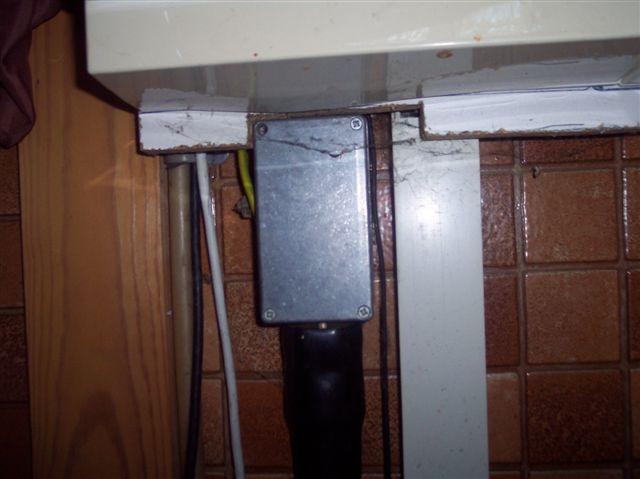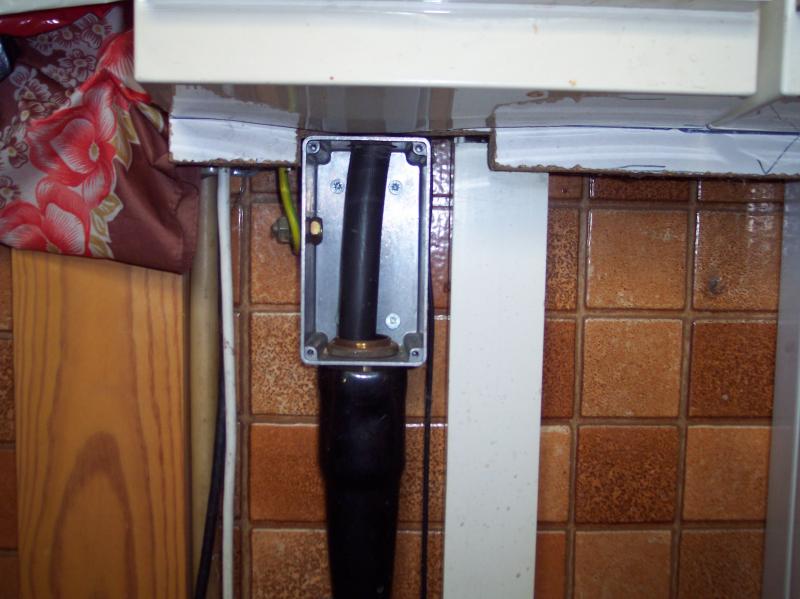You are using an out of date browser. It may not display this or other websites correctly.
You should upgrade or use an alternative browser.
You should upgrade or use an alternative browser.
SWA - Consumer unit or external box?
- Thread starter Benway
- Start date
Sponsored Links
Advantages - less things to fix. No extra wall space.
Disadvantages - lack of space in the CU, and if it's a plastic one, insufficient rigidity. More wall space (but probably where the cable would run anyway).
Disadvantages - lack of space in the CU, and if it's a plastic one, insufficient rigidity. More wall space (but probably where the cable would run anyway).
What's the earthing arrangement going to be?
Sponsored Links
Usually there is only one reason to use the seperate box - and that is because the consumer unit is plastic.
It may be that the design of the plastic consumer unit will not easily accept an SWA gland, so the inner cable of the SWA can run through the glanded box into the cu.
There may be no need for the seperate box.
Either way, the SWA gland and armour must be earthed, this is usually achieved at the supply end - somehow that seems safer.
I like to waste resources and earth both ends of the armour when I can, because it's belt, braces and two condoms.
It may be that the design of the plastic consumer unit will not easily accept an SWA gland, so the inner cable of the SWA can run through the glanded box into the cu.
There may be no need for the seperate box.
Either way, the SWA gland and armour must be earthed, this is usually achieved at the supply end - somehow that seems safer.
I like to waste resources and earth both ends of the armour when I can, because it's belt, braces and two condoms.
Last edited:
I like to waste resources and earth both ends of the armour when I can, because it's belt, braces
Judging from some switchgear lately, the way the earthbars connect to the metal casing seems pretty poor, they seem more to Earth the Box to the Bar rather than vise versa, so I too would always Fit a link if the situation warrented it
Or there just isn't room for a 25mm gland....Usually there is only one reason to use the seperate box - and that is because the consumer unit is plastic.
If the CU is metal then you've got no choice at that end.I like to waste resources and earth both ends of the armour when I can, because it's belt, braces and two condoms.
And the new CU at the other end will "have to be" metal.
External for me.. much easier..
Armouring glanded to the die cast box before it is screwed to the wall.
Only the inner sheath and cores taken into the CU. ( There should have been a grommet on the hole for the sheath and cores. )
The die cast box is connected to the MET to provide earthing for the armouring.
Metal CU at the far end may have to be isolated from the armouring if the far end is TT ( no exported earth permitted )
Armouring glanded to the die cast box before it is screwed to the wall.
Only the inner sheath and cores taken into the CU. ( There should have been a grommet on the hole for the sheath and cores. )
The die cast box is connected to the MET to provide earthing for the armouring.
I like to waste resources and earth both ends of the armour when I can, because it's belt, braces .
If the CU is metal then you've got no choice at that end.
Metal CU at the far end may have to be isolated from the armouring if the far end is TT ( no exported earth permitted )
True, if it is.Metal CU at the far end may have to be isolated from the armouring if the far end is TT ( no exported earth permitted )
Probably no good reason for that, though:
.. it's TN-S.
If the supply bis TN-S then I agree that most, if not all, of the theoretical hazards which lead some people to favour TTing an outbuilding cease to exist.Probably no good reason for that, though:
However, another reason for TTing the outbuilding might be if there are extraneous-c-ps in the outbuilding that need bonding but the size of SWA which would be adequate for 'supply purposes' would not provide an adequate bonding conductor.
Kind REgards, John
If it is truly TN-S then large bonding conductors are not required.
Unfortunately, today, because of the negligence of the DNOs nearly everything has to be treated as PME.
Unfortunately, today, because of the negligence of the DNOs nearly everything has to be treated as PME.
True, but I think it could probably still be more than would be provided by small-CSA SWA.If it is truly TN-S then large bonding conductors are not required.
However, as you imply, it seems that they rarely 'mend' TN-S earths but, instead, convert them to TN-C-S - so, as you say, I don't think one can rely on a (currently) TN-S earth to always remain TN-S.
Kind Regards, John
In true TN-S the bonding conductor doesn't have to be run back to the MET.; just installed in the out building.True, but I think it could probably still be more than would be provided by small-CSA SWA.
In the out building, it just has to be half the csa of the required earthing conductor, so the earthing conductor back to the house is used.
I don't have access to regs etc. at the moment, but do they really say that?In true TN-S the bonding conductor doesn't have to be run back to the MET.; just installed in the out building.
I'm getting confused here. Isn't the "earthing conductor" just the conductor between the supplied earth (DNO TN earth or local electrode) and the MET? In any event, a (non-PME) main bonding conductor is, as you say, required to be at least half the CSA of the required earthing conductor but with a minimum of 6mm², and I have always taken that to relate to a copper conductor - is that not correct? If I am right, does, say, 2-core 2.5mm² SWA have an armour with a copper-equivalent CSA of at least 6mm² ?In the out building, it just has to be half the csa of the required earthing conductor, so the earthing conductor back to the house is used.
Kind Regards, John
Well they may not actually say that but that is the outcome.I don't have access to regs etc. at the moment, but do they really say that?
As in the house, the earthing conductor is sized by the adiabatic equation and bonding conductors half of that - subject to the minimum, of course - but is that for electrical reasons?.
Yes, sorry, I should have said CPC - although it will be the earthing conductor for the out-building, won't it?I'm getting confused here. Isn't the "earthing conductor" just the conductor between the supplied earth (DNO TN earth or local electrode) and the MET?
It is correct.In any event, a (non-PME) main bonding conductor is, as you say, required to be at least half the CSA of the required earthing conductor but with a minimum of 6mm², and I have always taken that to relate to a copper conductor - is that not correct?
However, if a bonding conductor of, say 3mm², were all that were actually required (apart from the minimum specification) then, surely a copper equivalent of that would be required; not the 6mm² minimum.
I haven't looked it up, but if a 2.5mm² CPC (earthing conductor) is adequate for the supply in the out building then the equivalent of 1.25mm² is likely - if it needs to be used instead or as well as the CPC (EC).If I am right, does, say, 2-core 2.5mm² SWA have an armour with a copper-equivalent CSA of at least 6mm² ?
No different than if the house was supplied in 2.5mm² cable for a, say, 30A supply.
DIYnot Local
Staff member
If you need to find a tradesperson to get your job done, please try our local search below, or if you are doing it yourself you can find suppliers local to you.
Select the supplier or trade you require, enter your location to begin your search.
Please select a service and enter a location to continue...
Are you a trade or supplier? You can create your listing free at DIYnot Local
Sponsored Links



